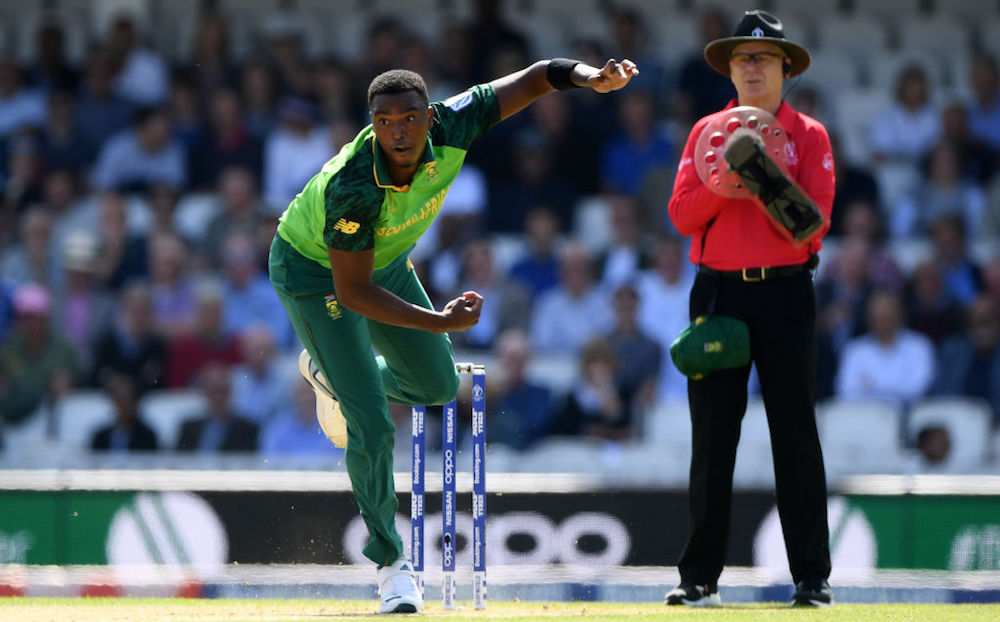Played seven, won one, the most embarrassing World Cup campaign in South Africa’s cricketing history. Protea Fire? More like Proteas Dire, writes GARY LEMKE.
Coming into this competition many voices – including South African coach Ottis Gibson – reckoned that South Africa’s bowling attack was the best in the competition and at the heart of it was their pacemen, led by Kagiso Rabada and Lungi Ngidi. What Gibson, whose contract expires in September but who ought be put out of his misery at the end of this World Cup, failed to do was also concentrate on selecting batsmen to do the job.
They have three times been asked to score 300 runs in this tournament and twice have come horribly unstuck, the latest train smash coming against Pakistan at Lord’s where they scored 259-9 chasing 309 to win. Batting has been one of South Africa’s three problems at this World Cup, the other two being the bowling and the fielding.
But, let’s talk about the bowling, which was so hyped. Did Cricket SA and the coaching staff pull the wool over the eyes of the public in terms of transparency over fitness? History will show that they gambled on the fitness of Dale Steyn and Ngidi and it didn’t work out for them. But, let’s just look at what has transpired at this World Cup.
Ngidi has only bowled 33 overs, taking seven wickets (7-211) at an economy rate of 6.39 runs per over.
Rabada has bowled 58 overs, taking six wickets (6-305) at an economy rate of 5.26 runs per over. That’s 13 wickets in total from the two premier fast bowlers combined. Now, Ngidi is 23 years old and Rabada 24. So, let’s compare apples with apples.
Jofra Archer is England’s fast-bowling go-to man. He is also 24 years old and at this World Cup he has bowled 55 overs, taking 15 wickets (15-269) at an economy rate of 4.89 runs per over.
Australia’s Mitchell Starc has taken 15 wickets, as has Pakistan’s Mohammad Amir. New Zealand have Lockie Ferguson. He’s bowled 45 overs, taking 14 wickets (14-217) at an economy rate of 4.82.
The fast bowlers have been the ones taking the most wickets in this World Cup and the list is headed by Archer (15), Starc (15), Amir (15), Ferguson (14), Mark Wood (12) and Pat Cummins (11). The leading South African is Chris Morris with nine wickets for 171 runs at an economy rate of 4.73. He’s clearly been South Africa’s best operator in the competition and has thumbed his nose at the selectors who left him out of the initial 15-man squad, bringing him in as a late replacement for Anrich Nortje.
The two main guns, Rabada and Ngidi, haven’t turned up at this tournament and in the field against Pakistan one could plainly see that Ngidi isn’t 100% fit and favouring that troublesome hamstring of his, while Rabada needs a rest and there are worrying signs that if he is not better managed in the next year or two he will not reach the giddy career heights predicted of him. Burnout is a real thing.
Both Rabada and Ngidi have been pale shadows of the ‘fearsome twosome’ that was supposed to run through batting lineups at this World Cup and set the Proteas on the road to tournament glory.
Curiously, in 22 career ODI matches, Ngidi has only bowled his full 10 overs on five occasions, which encourages the questions about his fitness. Why has he bowled his full complement less than 25% of the time?
Against Pakistan his three wickets came late in the innings when the chase was on and it was again noticeable how he reverted to the slower ball – as he had done previously in the tournament – late on. Fitness issues?
In his opening spell both he and Rabada had let Pakistan get away, with Ngidi’s first three overs costing 25 runs as he bowled too full and too wide, and when you do that at 135km/h, the ball is begging to be hit to the ropes.
In the field too, the Proteas have underperformed as a unit and against Pakistan again failed to convert close-run singles into run-outs because they weren’t able to secure direct hits on the stumps. And, perhaps the situation was summed up best with the last ball of Pakistan’s innings when Faf du Plessis gently looped the ball to Ngidi who was unable to catch it cleanly and run out Shadab Khan.
With the bat Hashim Amla and Aiden Markram continued their poor tournaments, and the highest score – with 309 runs needed – was Faf du Plessis’ 63. In seven matches no South African batsman has even reached 70 runs.
Which will allow their critics to suggest there are only three things wrong with this South African team: they can’t bat, can’t bowl and can’t field. That might sound overly harsh and it’s not an original line in cricketing folklore, but if it makes the Proteas the laughing stock of this World Cup it’s because they are.
.







